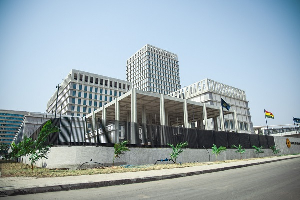Accra, May 26, GNA - Ghanaians have been urged to avail themselves of the abundant local materials found in their surroundings for the building and construction of their homes.
Professor Kwesi Andam, Vice-Chancellor of the Kwame Nkrumah University of Science and Technology, Kumasi, who made the call, said the use of materials within ones environs was the first step towards reducing the cost of a building project.
He was speaking at the inaugural lecture of the Ghana Academy of Arts and Science in Accra on: "Bricks, Blocks and The Future Administrative Capital of Ghana."
Professor Andam said while there existed an abundance of clay and sand for making bricks, most Ghanaian houses were being constructed with sandcrete blocks - blocks made from sand, water and cement. "This is highly undesirable because sandcrete blocks possess and intrinsic low compressive strength making them susceptible to any tragedy such as seismic activity."
Prof Andam said clay bricks, which are stronger, had been unable to mount any credible challenge to sandcrete blocks due mainly to the more difficult process of manufacturing bricks.
Research, he said, had also shown the dismal results for the production of sandcrete blocks, which had exhibited compressive strengths far below the standardised requirements for the construction of houses.
Sandcrete blocks may be used for construction purposes but at present, the more viable option would be the use of clay bricks, he said.
Brick houses, he said, required no painting and were easy to maintain since they did not develop cracks over time, adding that it was high time Ghana switched to the use of burnt bricks in the construction of houses.
Turning to the creation of a new Administrative Capital for Ghana, Prof Andam said a new capital was required so that Accra would ascend its real status as the country's economic capital. He said the chaotic nature of Accra such as constant flooding, dark and unnumbered streets, improper layout and lack of potable water among other things did not make it a befitting capital for the country. He said although conditions in Accra were improving a lot more resources would have to be channelled to bring the city to acceptable standards.
Besides, the city's situation in an earthquake zone and the poor structural designs of buildings made it disaster prone area should there be strong seismic activity.
Seventy per cent of houses in Accra, he said, were not designed. Professor Andam said a new capital would allow for proper planning and layout of structures to make it an ideal home. He gave the condition for the establishment of a new capital as proximity to a coastline, moderate rainfall and situation around a large unpolluted water body.
Prof Andam said based on these criteria a future site for a new Administrative capital of Ghana should be in the Shama and Beposo areas in Western Region, which fell on the west and east banks of the River Pra.
"Further studies have also shown that the site holds considerable promise and should be investigated further to ascertain its potential to becoming Ghana's future administrative capital," he said. However, he said, that the creation of a new capital would demand sacrifices and inputs from the populace. Prof Andam said the best approach now was to stop building and expanding Accra and to start the development of a new administrative capital. 27 May 04
General News of Wednesday, 26 May 2004
Source: GNA
















